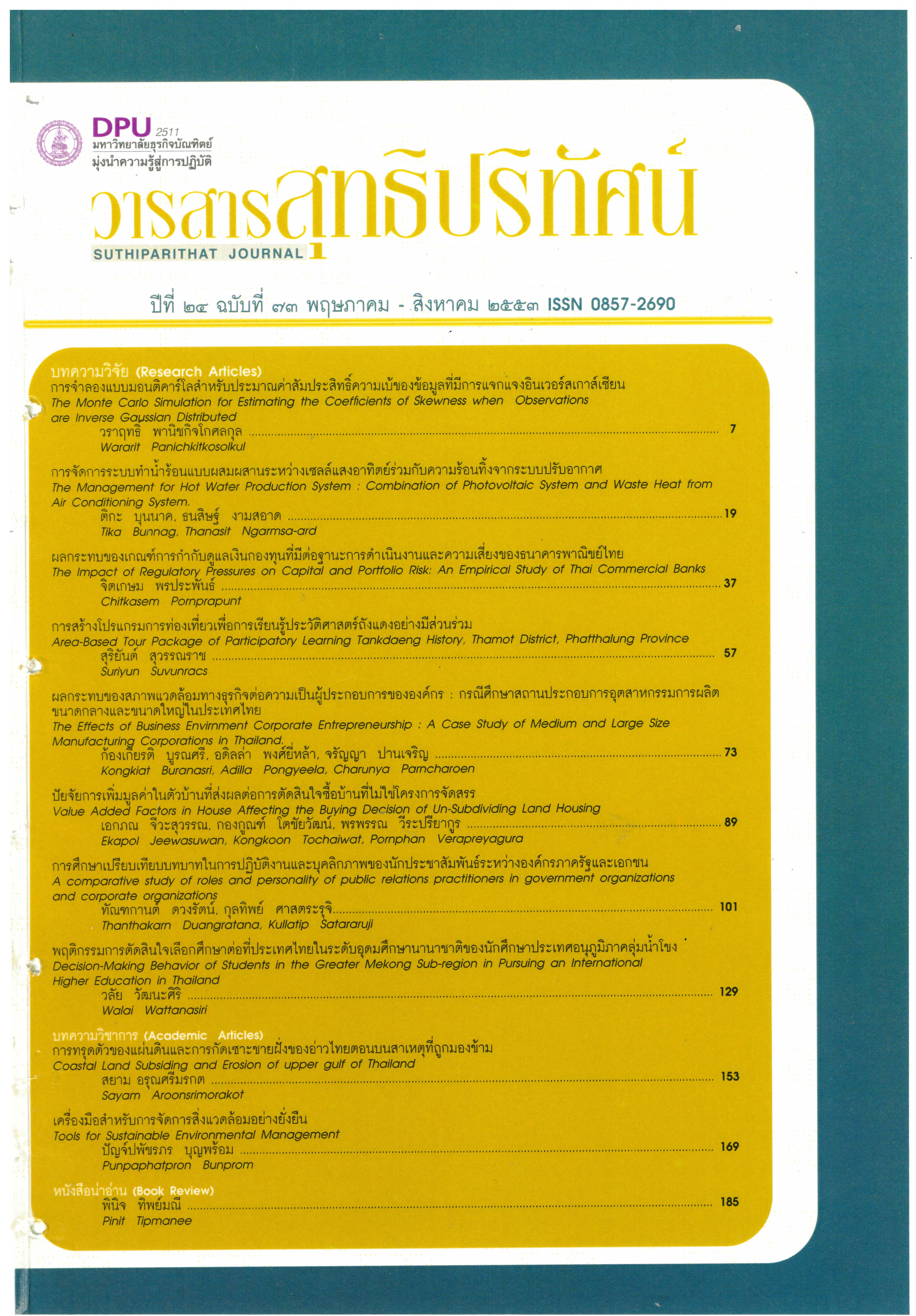ผลกระทบของเกณฑ์การกำกับดูแลเงินกองทุนที่มีต่อฐานะการดำเนินงานและความเสี่ยงของธนาคารพาณิชย์ไทย
คำสำคัญ:
เกณฑ์การกำกับดูแลเงินกองทุน, เงินกองทุนรวมความเสี่ยง, ความเสี่ยงทางการเงิน (Portfolio Risk), มาตรฐานสากล Basel, การบิดเบือนทางจริยธรรม, และธนาคารพาณิชย์ไทยบทคัดย่อ
นโยบายของธนาคารกลางและผู้กำกับดูแลสถาบันการเงินมุ่งรักษาเสถียรภาพ ระบบสถาบันการเงินโดยเน้นการกำกับดูแลความมั่นคงแข็งแกร่งของสถาบันการเงิน การออกกฎเกณฑ์มาตรฐานขั้นต่ำการดำรงเงินกองทุนตามมาตรฐานสากล (Basel I) ยังเป็นข้อถกเถียงทั้งในเชิงทฤษฎีและภาคปฏิบัติโดยกฎเกณฑ์ดังกล่าวอาจส่งผลให้ สถาบันการเงินเพิ่มเงินกองทุน และลดความเสี่ยงทางการเงิน ในอีกด้านหนึ่งการที่ สถาบันการเงินมีเงินกองทุนเพิ่มขึ้นก็ส่งผลให้ Leverage เพิ่มขึ้น และความเสี่ยงเพิ่มสูงขึ้นจากปัญหาการบิดเบือนทางจริยธรรม (Moral Hazard) ของสถาบันการเงิน บทความนี้มุ่งศึกษาเชิงประจักษ์เกี่ยวกับผลกระทบของเกณฑ์การกำกับดูแลเงินทุนของทางการที่มีต่อฐานะเงินกองทุนและความเสี่ยงทางการเงิน โดยใช้ข้อมูลของธนาคารพาณิชย์ไทยเพื่อวิเคราะห์เชิงปริมาณจากสมการถดถอย Simultaneous Equations ตามวิธี Generalized Method of Moments (GMM) ซึ่งเน้นศึกษาผลกระทบของตัวแปรนโยบายด้านมาตรการป้องกันและแก้ปัญหาเงินกองทุน ผลการศึกษาพบว่าเกณฑ์การกำกับดูแลเงินกองทุนส่งผลให้ธนาคารพาณิชย์มีการปรับตัวทางด้านฐานะเงินกองทุนและความเสี่ยงทางการเงิน และพบว่าเงินกองทุนและความเสี่ยงทางเงินของธนาคารพาณิชย์มีความสัมพันธ์กันในเชิงผกผัน
เอกสารอ้างอิง
Aggarwal R., and Jacques K. (1998) “Assessing the Impact of Prompt Corrective Action on Bank Capital and Risk,” Federal Reserve Bank of New York Economic Policy Review, October. pp. 23-32.
Bouri A., and Hmida B. A. (2006) “Capital and risk taking of banks under regulation: A simultaneous equations approach in the Tunisian context,” Journal of Finance 36, pp. 51-60.
Dewatripont M., and Tirole J. (1999) “The Prudential Regulation of Banks,” Second Printing. The Walras-Pareto Lectures. Universite de Lausanne.
Dietrich K., and James C. (1983) “Regulation and the Determination of Bank Capital Changes: A Note,” The Journal of Finance, Vol. 38, No. 5. pp. 1651-1658.
Ediz T., Michael I., and Perraudin W. (1998) “The Impact of Capital Requirements on U.K. Bank Behavior,” Federal Reserve Bank of New York Economic Policy Review, October. pp. 15-22.
Furlong F. T., and Keeley M. C. (1989) “Capital Regulation and Bank Risk-Taking: A Note,” Journal of Banking and Finance, 13. pp. 883-891.
Hart O. D., and Jaffee D. M. (1974) “On the Application of Portfolio Theory to Depository Financial Intermediaries,” Review of Economic Studies, 41. pp. 129-147.
Heid F., Porath D., and Stolz S. (2003) “Does Capital Regulation Matter for Bank Behavior? Evidence for German Savings Banks,” Kiel Institute for World Economics, Kiel Working Paper No.1192.
Hussain M. E., and Hassan M. K. (2006) “Committee Requirements and Bank Credit Risk Taking in Developing Countries.” Network Financial Institute Working Paper No. 2006-WP-10.
Jacques K., and Nigro P. (1997) “Risk-Based Capital, Portfolio Risk, and Bank Capital: A Simultaneous Equations Approach,” Journal of Economics and Business, 49: pp. 533-47.
Keeley M. C., and Furlong F. T. (1990) “A Reexamination of Mean-Variance Analysis of Bank Capital Regulation,” Journal of Banking and Finance, 14. pp. 869-84.
Kim D., and Santomero A. M., (1988) “Risk in Banking and Capital Regulation,” Journal of Finance, 43. pp. 1219-1233.
Kleff V., and Weber M. (2004) “How Do Banks Determine Capital ? Evidence from Germany,” Center for European Economic Research (ZEW), University of Mannheim and Centre for Economic Policy Research (CEPR).
Koehn M., and Santomero A. M. (1980) “Regulation of Bank Capital and Portfolio Risk,” Journal of Finance, 35. pp. 1235-1244.
Matejašák M., and Teplý P.(2007) “Regulation of Bank Capital and Behavior of Banks: Assessing the US and the EU-15 region Banks in the 2000-2005 period,” IES Working Paper: 23/2007. Institute of Economic Studies, Faculty of Social Science, Charles University in Prague, Czech Republic.
Merton R. C. (1977) “An Analytic Derivation of the Cost of Deposit Insurance and Loan Guarantees,” Journal of Banking and Finance, 1. pp. 3-11.
Mingo J. J. (1975) “Regulatory Influence on Bank Capital Investment,” The Journal of Finance, Vol. 30, No. 4. pp. 1111-1121.
Murinde V., and Yaseen H. (2004) The Impact of Accord Regulations on Bank Capital and Risk Behavior: 3D Evidence from the Middle East and North Africa (MENA) Region Prepared for the 3rd International Conference of the Center for Regulation and Competition, Institute for Development Policy and Management, University of Manchester.
Nachan D.M., Narain A., Ghosh S., and Sahoo S. (2000) Capital Adequacy Requirements and The Behavior of Commercial Banks in India: An Analytical and Empirical Study Development Research Group Study No. 22, Department of Economic Analysis and Policy, Reserve Bank of India, Mumbai.
Peltzman S. (1970) “Capital Investment in Commercial Banking and Its Relationship to Portfolio Regulation,” Journal of Political Economy, 78. pp. 1-26.
Pyle D. H. (1984) “Deregulation and Deposit Insurance Reform,” Federal Reserve of San Francisco Economic Review, Spring. pp. 5-15.
Rime B. (2001) “Capital Requirements and Bank Behavior: Empirical Evidence for Switzerland,” Journal of Banking and Finance, 25. pp. 798-805.
Rochet J. C. (1992) “Capital Requirements and the Behavior of Commercial Banks,” European Economic Review, 36. pp. 1137-1178.
Roy P. V. (2003) Impact of the 1988 Accord on Bank’s Capital Ratios and Credit Risk Taking: An International Study Working Paper. European Center for Advanced Research in Economics and Statistics, Universite Libre de Bruxelles.
Shrieve R. E., and Dahl D. (1992) “The Relationship between Risk and Capital in Commercial Bank,” Journal of Banking and Finance, 16. pp. 439-57.
Stolz S., (2007) Bank Capital and Risk-Taking: The Impact of Capital Regulation, Charter Value, and the Business Cycle Kiel Institute for the World Economy, Springer-Verlag Berlin Heidelburg, Germany.
ดาวน์โหลด
เผยแพร่แล้ว
รูปแบบการอ้างอิง
ฉบับ
ประเภทบทความ
สัญญาอนุญาต
เนื้อหาและข้อมูลในบทความที่ลงตีพิมพ์ในวารสารสุทธิปริทัศน์ ถือเป็นข้อคิดเห็นและความรับผิดชอบของผู้เขียนบทความโดยตรงซึ่งกองบรรณาธิการวารสาร ไม่จำเป็นต้องเห็นด้วย หรือร่วมรับผิดชอบใด ๆ
บทความ ข้อมูล เนื้อหา รูปภาพ ฯลฯ ที่ได้รับการตีพิมพ์ในวารสารสุทธิปริทัศน์ ถือเป็นลิขสิทธิ์ของวารสารสุทธิปริทัศน์หากบุคคลหรือหน่วยงานใดต้องการนำทั้งหมดหรือส่วนหนึ่งส่วนใดไปเผยแพร่ต่อหรือเพื่อกระทำการใด ๆ จะต้องได้รับอนุญาตเป็นลายลักษณ์อักษรจากวารสารสุทธิปริทัศน์ก่อนเท่านั้น







